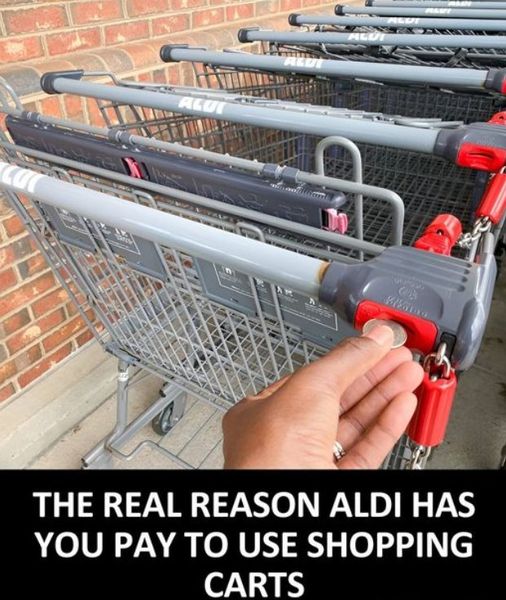If you’ve ever shopped at Aldi, you’ve probably noticed something a little different the moment you stepped out of your car—you need a quarter to get a shopping cart. At first glance, this might seem like an inconvenience or just another quirky policy, but there’s actually a well-thought-out reason behind it. In fact, this simple system plays a big role in how Aldi operates, helping the grocery chain maintain its reputation for low prices, efficiency, and customer-focused service. So if you’ve ever wondered why Aldi makes you pay to use a shopping cart, let’s break it down.

The most obvious reason for the cart deposit system is simple: it motivates customers to return their carts. Instead of hiring employees to chase carts around the parking lot all day, Aldi encourages shoppers to bring the cart back themselves in order to get their quarter back. That small financial nudge—just 25 cents—is surprisingly effective. It keeps carts from being abandoned all over the lot and helps maintain a cleaner, more organized shopping environment. Shoppers are more likely to do their part when there’s a little incentive waiting for them at the end.
But there’s more to it than just tidiness. Aldi is all about saving money and passing those savings on to its customers. Every detail of their store operations is designed with cost-efficiency in mind, and that includes how they manage carts. By not needing to pay workers to collect carts, Aldi reduces labor costs. Those savings may seem small on their own, but they add up—and they help Aldi keep its prices lower than many of its competitors. For customers who are shopping on a budget, that quarter-back cart system actually plays a tiny role in helping their dollars stretch further.
This cart system is just one piece of Aldi’s bigger strategy. The company runs a no-frills operation, and part of that includes minimizing overhead costs wherever possible. You won’t see flashy displays, in-store bakeries, or endless brand-name options. Aldi’s focus is on efficiency, and instead of hiring extra staff to handle tasks that customers can easily do themselves—like returning a cart—they streamline everything. It’s not about cutting corners; it’s about being smart with every dollar so the savings can be passed on to you.
Another perk of the cart system is that it subtly encourages environmentally friendly habits. Aldi has also gained attention for its push to reduce plastic waste. In most stores, plastic and paper bags aren’t given out for free—you either bring your own bags or pay a small fee for reusable ones. In that same spirit, the cart system nudges shoppers to think ahead and be a little more conscious about their shopping routines. It promotes a culture of personal responsibility and sustainability, values that are becoming more important to consumers.
On top of that, there’s something refreshing about Aldi’s approach to accountability. By asking customers to return their carts and handle their own bags, the company builds a kind of mutual respect between the store and its shoppers. You’re trusted to play a small role in keeping the store running smoothly, and in return, you get low prices and efficient service. It fosters a sense of community responsibility, and believe it or not, that quarter system actually contributes to that.
And here’s the thing: Aldi isn’t trying to make money off the cart deposit. That 25 cents is fully refundable. As soon as you return your cart to the corral and reattach the chain, your coin pops back out. It’s not a fee, it’s a deposit—and one you’re likely to get back unless you’re feeling extra generous and leave your cart for someone else to use. It’s a clever, fair, and simple system that doesn’t cost you anything if you follow the process.
So while it may seem strange at first, Aldi’s cart policy actually makes a lot of sense. It’s efficient, it helps keep costs low, it encourages good habits, and it reinforces the idea that every shopper plays a small part in creating a better experience. It’s not about making you jump through hoops—it’s about making things work better for everyone. And next time you shop there, you’ll know that the quarter in your pocket is more than just change—it’s a key to smarter shopping.





